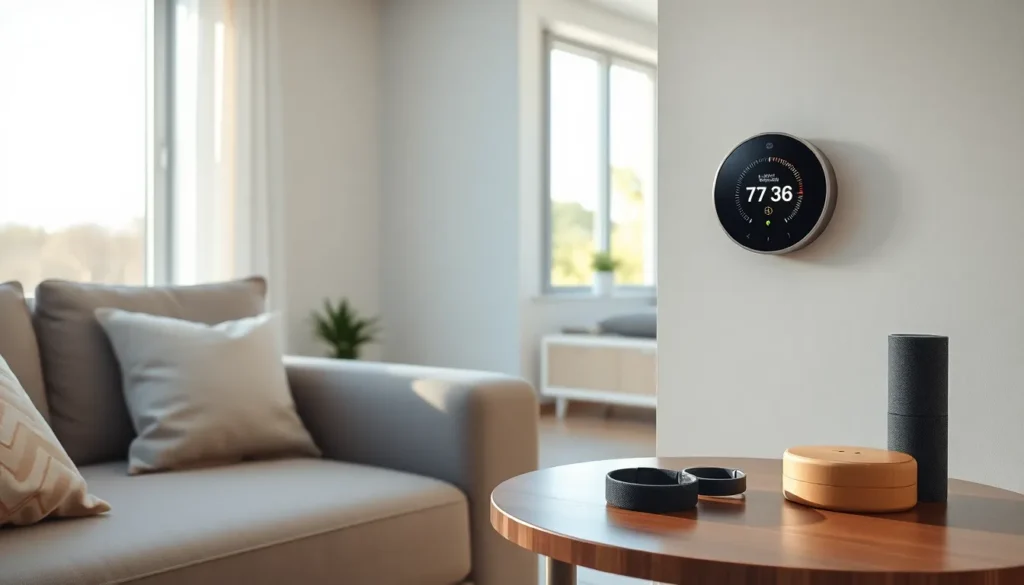Table of Contents
ToggleImagine a world where your toaster knows just how crispy you like your bagels and your fridge reminds you when you’re out of milk. Welcome to the Internet of Things (IoT), where everyday objects are getting smarter and more connected than ever. This technological marvel isn’t just for techies; it’s transforming homes and businesses, making life easier and a tad more entertaining.
As devices start chatting with each other, they’re not just sharing gossip—they’re optimizing your life. From smart thermostats that learn your preferences to wearables that track your health, IoT is revolutionizing how we interact with the world around us. Buckle up, because this digital ride is just getting started, and you won’t want to miss out on the convenience and innovation it brings.
Overview Of The Internet Of Things
The Internet of Things (IoT) connects various devices to the internet, enabling seamless communication and data exchange. Sensors in smart devices collect data, allowing them to analyze behaviors and optimize performance. Examples of IoT applications include smart home systems, industrial automation, and health monitoring.
Smart thermostats automatically adjust temperatures based on user preferences. They gather data from internal and external sources, ensuring energy efficiency while enhancing comfort. Another example is wearable health trackers, which monitor vital signs and activity levels. Users receive real-time feedback, promoting healthier lifestyles.
In industrial settings, IoT plays a crucial role in optimizing operations. Companies utilize connected machines to monitor performance and reduce downtime. Predictive maintenance alerts maintenance teams before equipment failure, saving money and time.
Security concerns arise with increased connectivity. Protecting networks from cyber threats becomes essential as more devices connect to the internet. Implementing robust security protocols prevents unauthorized access and safeguards sensitive data.
Market trends indicate significant growth in the IoT sector. Projections suggest that by 2030, there could be over 50 billion connected devices globally. This surge will likely improve efficiency in various industries, creating new business opportunities.
Integration of artificial intelligence enhances IoT capabilities. AI-driven algorithms analyze vast amounts of data collected from devices, providing valuable insights. Better decision-making processes emerge, driving innovation across sectors.
Overall, the Internet of Things reshapes how individuals and organizations interact with technology. Continued advancements promise greater convenience and efficiency in daily life. The journey of IoT continues to evolve rapidly, fostering a smarter, interconnected world.
Key Components Of The Internet Of Things

The Internet of Things relies on several key components that enable connectivity and functionality. Understanding these elements provides insight into how IoT transforms everyday life.
Sensors And Devices
Sensors and devices serve as the foundation of IoT. These components capture data from their surroundings, making them essential for functionality. Temperature sensors monitor environmental conditions, while motion detectors track human presence. Smart appliances, such as refrigerators and washing machines, also integrate sensors to enhance performance. Real-time data collection from these devices allows for immediate analysis and action, increasing automation and efficiency in homes and industries.
Connectivity
Connectivity plays a critical role in IoT. Devices require reliable communication networks to exchange data seamlessly. Various technologies, such as Wi-Fi, Bluetooth, and cellular networks, facilitate this connectivity. Each technology presents unique strengths—for example, Wi-Fi offers high bandwidth for large data transfers, while Bluetooth is ideal for connecting nearby devices. These networks help spread IoT’s reach across smart homes, transportation systems, and industrial environments, enabling the sharing of information with minimal delay.
Data Processing
Data processing is vital for turning raw data into actionable insights. After collection, data must be analyzed to drive intelligent decision-making. Cloud computing platforms and edge computing solutions frequently handle this processing. Each approach has its advantages; cloud computing enables centralized storage and analysis, while edge computing allows for local processing, reducing latency. Thus, organizations can leverage data effectively, optimize operations, and enhance user experiences through informed actions.
Applications Of The Internet Of Things
The Internet of Things (IoT) has numerous applications across various sectors, enhancing efficiency and interconnectivity.
Smart Home Technology
Smart home technology allows devices to communicate, creating a seamless living environment. Homeowners enjoy smart thermostats that intelligently adjust temperatures based on personal preferences. Security systems, equipped with sensors, provide real-time alerts about unusual activities. Lighting can be controlled remotely, optimizing energy use. Voice-activated assistants play a crucial role by integrating with various devices, offering convenience at one’s fingertips. Overall, smart home applications elevate daily living experiences through automation and enhanced control.
Industrial IoT
Industrial IoT revolutionizes manufacturing and operational efficiencies. Factories leverage connected sensors to monitor equipment performance continuously. Predictive maintenance reduces downtime by signaling potential machinery failures before they occur. Supply chain management becomes more efficient through real-time tracking of assets. Additionally, data analytics from IoT devices provides insights that enable better decision-making. Enhanced productivity results from improved workflows and reduced operational costs, making industrial IoT a game-changer in the business sector.
Healthcare Innovations
Healthcare innovations harness IoT to improve patient outcomes and streamline operations. Wearable devices monitor vital signs and deliver real-time health data to medical professionals. Telehealth services enable remote patient monitoring, making healthcare more accessible. Connected medical equipment tracks medication adherence and alerts patients about essential treatments. Further, analytics from IoT devices assist in identifying health trends, enhancing preventive care strategies. Overall, IoT applications in healthcare significantly transform how patients and providers interact.
Challenges And Considerations
The Internet of Things presents various challenges that require attention. Security risks represent a primary concern in this evolving landscape. As more devices connect to the internet, potential vulnerabilities increase. Cybercriminals exploit weak security protocols, leading to unauthorized access and data breaches. Organizations must prioritize implementing robust encryption methods and regular security updates to safeguard networks. Collaborative security measures among manufacturers also enhance the protection of interconnected devices.
Privacy issues further complicate the IoT ecosystem. With devices constantly collecting and transmitting data, user consent and data ownership become critical. Individuals may unknowingly share sensitive information through everyday devices, leading to potential misuse. Data management policies must address these concerns while promoting transparency in data usage. Businesses should design privacy-centric frameworks that ensure user data protection and empower consumers to control their information. Maintaining trust hinges on the ability to balance innovation and user privacy effectively.
Future Of The Internet Of Things
Growth expectations for the Internet of Things (IoT) are remarkable. Projections indicate over 50 billion connected devices by 2030, significantly enhancing efficiency across various sectors. Organizations actively pursue IoT advancements, aiming for smarter operations and improved user experiences.
Artificial intelligence integration serves as a catalyst for IoT development. AI enhances data analysis, allowing companies to make informed decisions quickly and accurately. Opportunities abound, as businesses leverage these technologies to optimize services and drive innovation.
Healthcare transformation is underway due to IoT capabilities. Wearable devices continuously monitor vital signs, empowering individuals to manage their health. Telehealth services also expand, enabling professionals to provide remote care without compromising quality.
Smart home systems connect devices to create a cohesive living environment. Homeowners benefit from automated features like temperature regulation and enhanced security. These interconnected systems elevate convenience, promoting a seamless daily life.
Industries are also evolving through industrial IoT applications. Real-time asset tracking in supply chains boosts operational efficiency significantly. Predictive maintenance reduces downtimes by ensuring that equipment stays functional, ultimately saving costs.
Cybersecurity remains a critical challenge as connectivity expands. Organizations prioritize robust encryption practices to defend against potential breaches. Privacy concerns also necessitate cautious frameworks to protect user data while fostering trust in IoT solutions.
Innovation will continue to reshape the IoT landscape. Stakeholders strive to develop applications that enhance everyday experiences in real-time. With ongoing advancements, it becomes increasingly evident that IoT holds the key to a smarter, more interconnected future.
The Internet of Things is undeniably shaping the future of technology and everyday life. As devices become increasingly interconnected the potential for enhanced efficiency and convenience grows. From smart homes to industrial applications IoT is revolutionizing how people interact with their environment.
However the challenges of security and privacy cannot be overlooked. Organizations must remain vigilant in protecting user data while embracing the innovations that IoT offers. As the landscape continues to evolve with advancements in artificial intelligence the opportunities for growth and improvement will expand even further.
The journey toward a more interconnected world is just beginning and the possibilities are endless.







